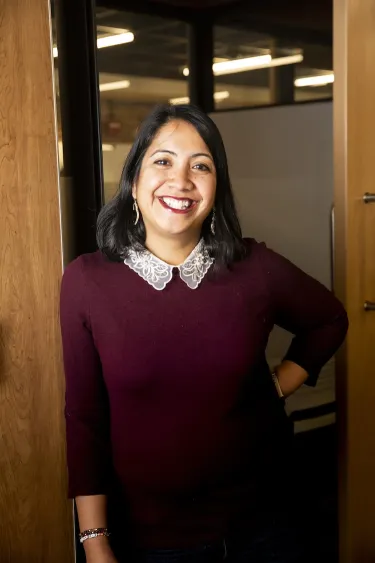
History Updated
When it comes to expanding how social studies is taught in the classroom, teacher educator Noreen Nasseem Rodriguez counsels a defined educational vision, clear and honest communication and a strong dose of hope.

Noreen Naseem Rodriguez, assistant professor in CU Boulder's School of Education
In the introduction to Paulo Freire’s Pedagogy of the Oppressed, the American theologian Richard Shaull wrote that there is “no such thing as a neutral educational process.” He wrote that “education either functions as an instrument that is used to facilitate the integration of the younger generation into the logic of the present system,” or it becomes “the means by which men and women deal critically and creatively with reality.”
Noreen Naseem Rodriguez, an assistant professor in the School of Education at CU Boulder, is preparing the next generation of teachers to shepherd their students through a rapidly changing educational landscape — one mired in controversies about teaching critical race theory, addressing gender identity in the classroom and what to include in or exclude from U.S. history classes — while making sure both students and teachers are able to deal “critically and creatively with reality.”
“Oftentimes, it’s the adults that are uncomfortable with these topics, not the kids,” Rodriguez said. “Kids just want to know, they want to understand the people around them, and they want to understand the world.”
Anti-Oppressive Social Studies
Last year, Rodriguez — who spent nine years as a primary school teacher in Texas — teamed up with Katy Swalwell, a fellow teacher educator, to publish a textbook, Social Studies for a Better World, after years of being dissatisfied with other textbooks. The overarching goal of the book is to offer advice for teaching controversial issues in the classroom and how to avoid potential repercussions.
“The last chapter is about how to do this work without getting fired,” Rodriguez said. “There’s this constant fear of upsetting people.”
Rodriguez acknowledges there is no guarantee a school or district will support what she calls an “anti-oppressive” social studies curriculum, an approach that takes into account the power differentials in society that perpetuate inequality and oppression.
Rodriguez’s interest in an anti-oppressive social studies approach developed after she participated in the Tejano History Curriculum Project, a program focused on expanding curricula to include people of Mexican descent living in Texas for many generations.
The existing state curriculum relies on settlers like Davy Crockett, glossing over significant histories from when Texas was a part of Mexico.
“Every single student, regardless of their race or their ethnicity, was all about learning this history that no one else knew — and I was learning right alongside with them,” Rodriguez said.
Rodriguez notes that some school administrators, community members and even colleagues might see such efforts as a dangerous threat to their authority or the status quo.
So it makes sense that the last chapter begins with advice that is foundational and motivational: Teachers should never stop believing that a better world is possible, nor stop imagining how circumstances, policies and practices can improve.
While Rodriguez is clear that teachers shouldn’t see themselves as saviors, she said, they need to be aware of the current challenges and harms that kids face. And she acknowledges it’s much easier if teachers know there are others on their side. Teachers are encouraged to think of students’ families as “their people,” especially those families that have long been demanding something better for their children.
For those families that might not understand or support anti-oppressive education, Rodriguez emphasizes the need for educators to be clear about their vision for social studies and to regularly communicate with colleagues, families and administrators about what they and their students are up to — and why.
Lastly, Rodriguez emphasizes that educators need to make time for their own continual growth, so they’re prepared for future challenges.
“Ultimately, this is about our democracy,” Rodriguez added. “You can’t prepare students to function in a democracy if they don’t understand people who are different from them and don’t know how to engage with them in productive ways.”
Photo by Matt Tyrie

